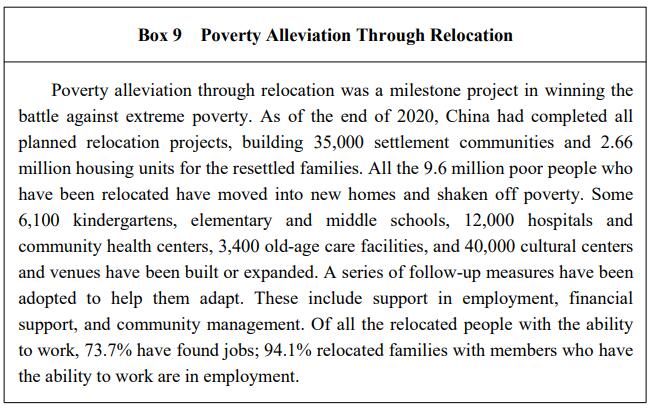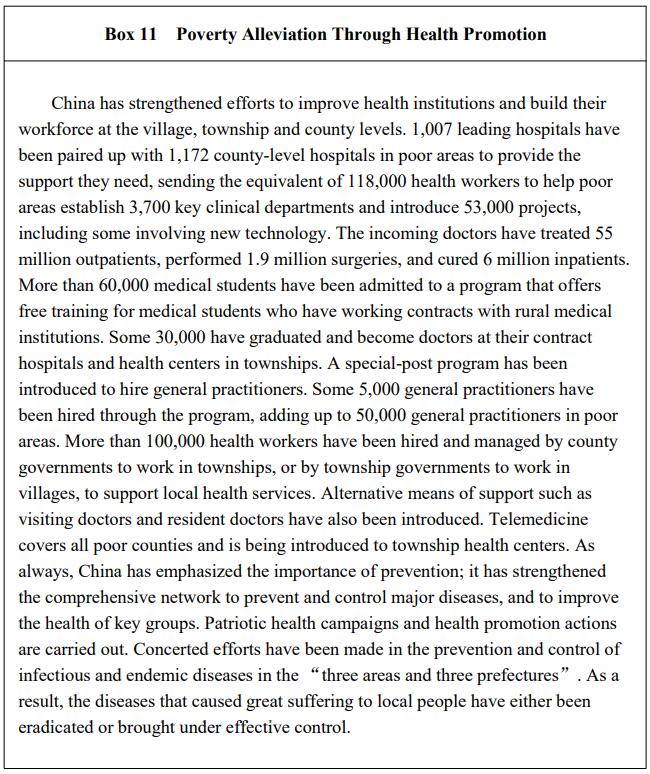Full Text: Poverty Alleviation: China's Experience and Contribution
The State Council Information Office of the People's Republic of China on Tuesday released a white paper titled "Poverty Alleviation: China's Experience and Contribution."
III.The Strategy of Targeted Poverty Alleviation
Identifying those truly in need is a universal problem in countries with a large population in poverty. Accurate identification of the poor and targeted measures is central to any effort to eradicate poverty. In its poverty elimination effort, China has actively learned from international experience, fully considered its actual conditions, and launched a series of guidelines and measures to increase efficiency, summarized as accomplishing "Targeted Efforts in Six Areas"[ This refers to efforts to identify the poor accurately, arrange targeted programs, utilize capital efficiently, take household-based measures, dispatch first Party secretaries based on village conditions, and achieve the set goals.], taking "Five Measures for Poverty Eradication"[ The measures include: boosting the economy to provide more job opportunities, relocating poor people from inhospitable areas, compensating for economic losses associated with reducing ecological damage, improving education in impoverished areas, and providing subsistence allowances for those unable to shake off poverty through their own efforts alone. ], and addressing "Five Questions in Poverty Alleviation"[ This refers to these questions: who should help, who should be helped, how to help, how to evaluate whether someone has emerged from poverty, and how to ensure those people stay free from poverty. ].
1. Identifying People in Need to Know Whom to Help
To help the poor, we must know who they are. China had a large poor population, which was complex in composition. China has developed a set of standards and procedures to accurately identify the poor, and grassroots officials have spent time in villages analyzing the distribution of the poor population, the causes of their poverty, and their needs. Poor households are identified primarily based on their incomes, with consideration given to other factors such as housing, education and health. Household applications for poverty registration are discussed and reviewed, disclosed for public supervision, and then evaluated by each level of administration. For administrative villages applying to be registered, consideration is given to the incidence of poverty, the per capita net income of the villagers, and income from businesses run by village collectives. Applications are filed by the village committee, reviewed and disclosed by the township government, and examined by the county government before the results are made public. The individuals and villages confirmed as poor are then registered and a file is created in the national poverty alleviation information system. Dynamic management of the poor population has been strengthened to remove those who have been wrongly identified and to add those newly identified, with an emphasis on accuracy. Through this registration system, for the first time in the history of poverty alleviation, China has identified every poor individual in every village, every poor household has the causes of their poverty and their needs registered with the government. The national information platform on poverty alleviation provides powerful IT support for targeted measures to realize the set goals.
2. Strengthening Leadership and Team-building to Know How to Offer Help
Poverty eradication work covers a wide range of areas and is extremely complex, thus requiring rigorous organization, leadership, and implementation. Relying on the CPC's political and organizational strength, China has established a poverty eradication management network with the central government acting as coordinator, provincial governments taking overall responsibility, and city and county governments overseeing implementation. The network covers all poor areas and officials are sent to villages to help every needy household. Party committees at all levels have assumed an overall coordinating role and assigned top officials to take charge of poverty eradication affairs. The leading officials of 22 provinces and equivalent administrative units in central and western China signed written pledges to the Party Central Committee, and Party secretaries at the five administrative levels of province, city, county, township and village have worked towards the same goal. During the poverty eradication campaign, Party committee secretaries and county governors have been required to remain unchanged in their posts. Areas tasked with poverty elimination worked out timetables with a clear division of responsibilities and pressed forward with implementation. In places where the work was particularly difficult, the fight against poverty became the top priority of social and economic development. Through the strictest possible evaluation and supervision, as well as specialized inspection tours, China has addressed any corruption and misconduct in poverty alleviation with rigor (Box 5), and strengthened the evaluation and supervision of results to ensure solid and authentic outcomes (Box 6) that can survive the test of time and practice. China has improved the incentives for encouraging officials to fulfill responsibilities and undertake initiatives, and the relevant mechanisms to protect their position. By giving more attention to and caring for officials and establishing the right approach to their selection and appointment, the government has given them the incentive to fulfill their duties and do their best in the final fight against poverty. China has strengthened its team of grassroots officials working in poverty alleviation, and formed resident working teams to assign officials to villages where they could be most useful. Officials on the resident working teams must be politically reliable and professional, and have a can-do approach to their work. Officials on these teams have dedicated themselves to their mission and fulfilled their duties, committing themselves to helping those in need on the front line of fighting poverty, and giving their all to help the poor find ways to emerge from poverty and seek development. The first group of first secretaries and resident working teams were dispatched to poor villages in 2013. By 2015, all poor villages had resident working teams, and every poor household a contact official in charge of poverty elimination. As of the end of 2020, 255,000 resident teams and more than 3 million officials had been dispatched as first secretaries and resident officials to poor villages, fighting on the front line of poverty alleviation alongside nearly 2 million township officials and millions of village officials.
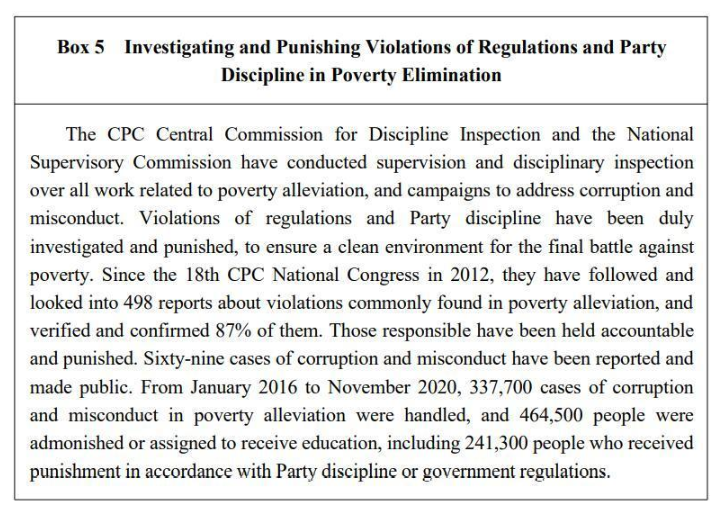
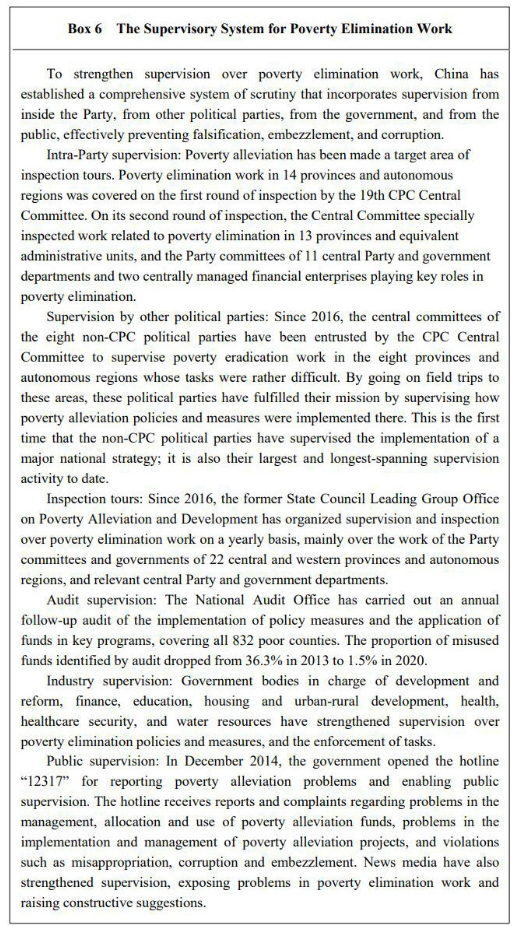
3. Applying Targeted Measures for Different Groups to Know How to Help
There are many different types of poverty and the causes vary from case to case. We cannot address the root cause without the right remedies. In practice, China has adopted categorized and targeted measures to reduce poverty, based on the situation of individual households, local conditions, and the causes for and types of poverty. These targeted measures include: boosting the economy to provide more job opportunities, relocating poor people from inhospitable areas, compensating for economic losses associated with reducing ecological damage, improving education in impoverished areas, and providing subsistence allowances for those unable to shake off poverty through their own efforts alone.
First, boosting the economy to provide more job opportunities. Poverty alleviation through economic development is the most direct and effective method, the fundamental way to give poor areas the capacity for independent development and help the poor find employment locally. With this in mind, China has supported and guided poor areas in developing economic activities geared to their available resources, and encouraged poverty alleviation through new forms of business and new industries such as e-commerce, photovoltaic (PV) power generation and tourism, and through the consumption of products and services from poor areas (Box 7). Relying on collaboration on poverty alleviation between the eastern and western regions, China has facilitated the transfer of food processing, clothes manufacturing, and other labor-intensive industries from the east to the west. With the growth of such specialty industries, poor areas have gained economic momentum. More than 300,000 industrial bases have been built, leading to the creation of new industries with distinctive features and greater capacity to facilitate poverty alleviation efforts. China has created 12,000 local agroproduct brands, 14,400 leading enterprises above the city level, and 719,000 rural cooperatives operated by farmers. A total of 72.6% of poor households have formed close ties with new types of agribusiness entities, and almost every poor household has been covered by policy support for boosting the economy. Almost all poor people with the ability and intention to work have joined the collective endeavor. Solid progress has been made in poverty alleviation through the development of science and technology. A total of 1,290 innovative platforms and business startups have been set up, and 77,000 people have been paired up with professionals to receive guidance on new technology in impoverished regions. With a team of 289,800 technicians and a fund of over RMB20 billion, China has launched 37,600 high-tech programs of all kinds and at all levels and introduced more than 50,000 advanced applied technologies and new, improved breeds. Poor households have received financial support such as small loans (Box 8). In poor villages, entrepreneurial individuals have been encouraged to start businesses and given support to help and lead others out of poverty.
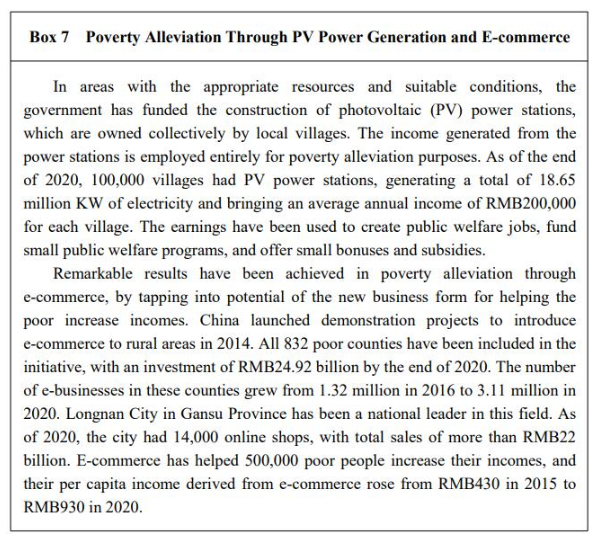
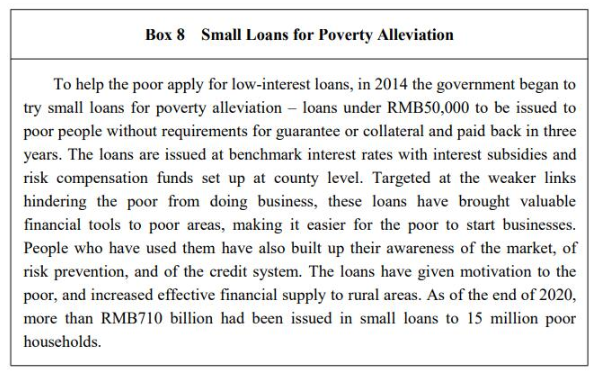
Second, relocating poor people from inhospitable areas. Some people lived in uninhabitable areas suffering from harsh natural conditions and subject to frequent natural disasters. It would be very hard for them to shake off poverty if they remained where they were, so the government relocated them to other areas (Box 9). The government respected these people's wishes, and only relocated those who were eligible and agreed to move. The reasons for relocation were explained to them but no coercion was used. The conditions and needs of target relocation groups were given full consideration, the scale of relocation was determined through research, and feasible plans were worked out and implemented in steps. As a result, more than 9.6 million people from inhospitable areas have shaken off poverty through relocation. Their former homes have been turned into farmland or planted with trees, to improve the eco-environment in these areas. In the resettlement sites, support facilities, industrial parks, and workshops have been built to create jobs for the relocated population, to ensure that they have stable incomes and equitable access to basic public services. Measures have been taken to ensure smooth relocation and resettlement, and make sure that those involved have the means to better themselves.
Third, shaking off poverty through compensations for economic losses associated with reducing ecological damage and getting eco-jobs. Clear waters and green mountains are invaluable assets. Laying equal emphasis on poverty alleviation and eco-conservation, China has strengthened ecological restoration and environmental protection in poor areas, increased government transfer payments to key eco-areas, and expanded the scope of those eligible for preferential policies. Poor people with the ability to work have thus been employed in eco-work, for example as forest rangers. Since 2013, a total of 4.97 million ha of farmland in poor areas has been returned to forest and grassland. A total of 1.1 million poor people have become forest rangers, and 23,000 poverty alleviation afforestation cooperatives/teams have been formed. By participating in projects for afforestation, turning reclaimed farmlands into forests or grasslands, restoring and protecting forests, grasslands and wetlands, and growing woody oil plants and working in forest tourism, the poor population have increased their incomes and made a major contribution to improving the eco-environment in poor areas, with mutually beneficial results.
Fourth, improving education in impoverished areas. Through education, poverty can be prevented from passing down from generation to generation (Box 10). The government has continued to increase support for schools in poor areas to improve their conditions, standard of teaching, faculties and financial resources. The state ensures compulsory education for all school-age children. All the 200,000 dropouts from compulsory education coming from poor families have returned to school. Favorable policies have been leveraged to enroll more poor students from designated areas, expand employment for graduates, and help students shake off poverty through vocational education. More than 8 million middle and high school graduates from poor families have received vocational training, 5.14 million poor students have received higher education, and key institutions of higher learning have admitted some 700,000 students from designated rural and poor areas. All this has opened up more channels for poor students to emerge from poverty and move upwards in society. The government has offered training on standard spoken and written Chinese language to 3.5 million rural teachers and young farmers and herdsmen in ethnic minority areas, in an effort to make poor people from these areas more competitive in the job market. A pilot campaign has been launched to teach standard Chinese to preschool children in Liangshan Yi Autonomous Prefecture, and Mabian Yi Autonomous County, Ebian Yi Autonomous County and Jinkouhe District in Leshan City, Sichuan Province, involving 430,000 children.
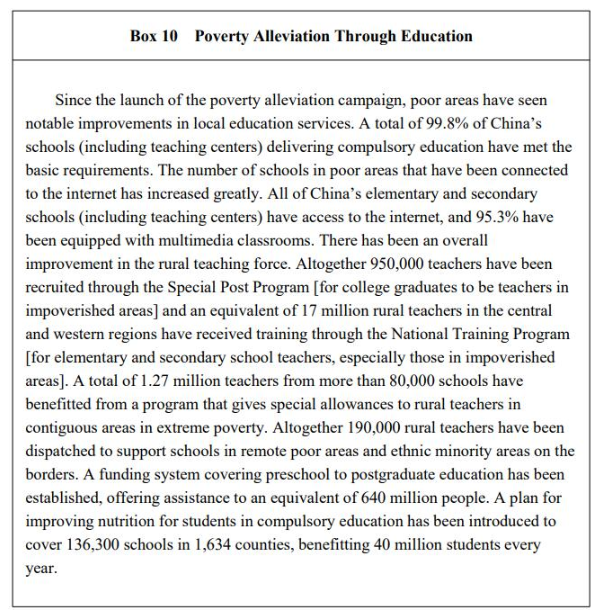
Fifth, providing subsistence allowances for those unable to shake off poverty through their own efforts alone. China focuses on the needs of the most vulnerable groups and provides them with subsistence allowances. Services and facilities to support people living in extreme poverty have been upgraded, with a greater capacity to provide care in service centers. The rural subsistence allowances framework has been effectively dovetailed with poverty alleviation policies, and the per capita yearly subsistence allowances in rural areas had grown from RMB2,068 in 2012 to RMB5,962 in 2020, an increase of 188.3%. The departments in charge of poverty alleviation and civil affairs compare data and verify information on a regular basis, to ensure full coverage of support for eligible groups.
China has also implemented many other forms of support for poverty alleviation that are consistent with local conditions. The government has redoubled its efforts to boost employment for the poor, through means such as offering free training on vocational skills, strengthening collaboration in the labor market between the eastern and western regions, supporting leading enterprises and workshops in poverty alleviation to create more jobs, encouraging entrepreneurial individuals to start businesses in their hometowns or villages, and creating public welfare jobs for the rest of the unemployed. Poor people who have the ability to work are encouraged to find employment locally or elsewhere, or start their own businesses. In 2015, 12.27 million poor laborers found employment; the figure had risen to 32.43 million in 2020. China has made efforts to improve healthcare service to the poor, considering it an important part of poverty alleviation in order to prevent the poor from sinking back into poverty due to illness (Box 11). China has launched a project to connect poor areas to the internet, introducing the "internet+" model for poverty alleviation in poor areas, especially in the extremely impoverished "three areas and three prefectures". The earnings from poverty alleviation funds and assets have been used to support the poor. The assets generated from facility agriculture – agriculture making extensive use of polytents and other similar equipment – PV power stations, and rural tourism using central government funds for poverty alleviation and other agriculture-related funds have been converted into shares and allocated proportionately to poor villages in order to give a boost to businesses, increase villagers' incomes and more importantly help solve the problem of generating revenue for the villages' collective economy. Since Covid-19 struck in 2020, China has adopted a series of support measures, such as measures to stabilize employment and encourage consumption of products from poor areas, effectively minimizing the impact of the virus.
4. Adopting Strict Criteria to Know When and How to Deregister Those Who Have Emerged from Poverty
A poverty exit mechanism has been established, with clear provisions on the standards and procedures for deregistering from the list poor counties, villages, and individuals. This prevents misconduct such as manipulation and falsification of data, and also prevents those who have emerged from poverty from keeping the label in order to continue accessing preferential treatment. The government has worked out a poverty deregistration plan and an annual poverty alleviation plan to ensure procedure-based, rational and orderly exit from the registers. The criteria and procedures have been strictly enforced, for example, by conducting public review in the case of individuals and government examination in the case of villages and counties. The results of poverty exit have been disclosed for public evaluation and review, based on transparent procedures, accurate data and complete files, to ensure fairness. Supervision and inspection have been strengthened, including annual evaluations by third parties of the deregistered population and counties, with a focus on remote areas with weaker economic foundations. Three parameters – the accuracy of decisions, the poverty incidence of recurrence among deregistered counties, and public rating of assistance measures – are emphasized in evaluation, to ensure accurate results. From 2020 to early 2021, China conducted a general survey of poverty elimination, collecting accurate data on progress in helping the poor out of poverty. A "grace period" is allowed for previously impoverished population, villages and counties, during which time poverty alleviation policies and government supervision are continued until their status is secure.
5. Conducting Follow-up Monitoring to Help People Stay Out of Poverty
People and locations will only be considered to have shaken off poverty when they have stayed out of it and have not fallen back in after a certain period. Counties have been given a five-year period of grace from the day they emerged from poverty. During this period they will continue to enjoy the main support policies, which will be adjusted and optimized by category. Over time the resources leveraged for intensive poverty elimination will be redirected towards an extensive drive for rural revitalization. China will improve its dynamic monitoring of any trends indicating a return to poverty, and improve associated support measures. It will regularly check on key groups, such as those who have just emerged from poverty but whose position is far from secure, those on the verge of poverty who can fall back in again easily, and those experiencing difficulties in meeting their basic needs due to expenditure induced by illness, disaster or accident, or due to a sharp drop in income, and exercise dynamic management to spot these trends early and intervene through support measures, so that these people do not fall back into poverty. China will continue to support formerly impoverished areas in developing their specialty industries and help those who have emerged from poverty have stable employment. Follow-up support will be given to the resettled population whose employment will be promoted through multiple means. The government will improve social management to help them integrate into society, so that they will stay out of poverty, remain employed and have a promising future. Systems and practices that have proven effective, such as resident first secretaries and working teams, eastern-western collaboration, paired-up assistance, and social assistance, will be continued and improved. Efforts will be intensified to help those who have emerged from poverty build up self-belief and have access to education, so that they can create a better life through their own hard work. More evaluation will be carried out over the status of formerly impoverished people and areas, and Party committees and governments at all levels will continue to take responsibility to ensure that people do not sink back into poverty in large numbers.
The strategy of targeted poverty alleviation is China's strongest weapon in its final battle to secure victory against poverty, and a major innovation in the theory and practice of poverty alleviation. It highlights the CPC's sound approach whereby all actions are based on actual conditions and conform to the needs of development; it is a manifestation of its courage to face up to new challenges and find solutions through trial and error; of its tireless exploration of the characteristics of governance by the CPC, the development of socialism, and the evolution of human society; and of its pursuit of all-round development of the people and common prosperity for all. In addition to securing a sweeping victory in the final battle against poverty, the strategy has also given a powerful boost to modernizing China's national governance system and capacity, and to enriching and developing the CPC's guiding philosophies and governance strategies in the new era.
